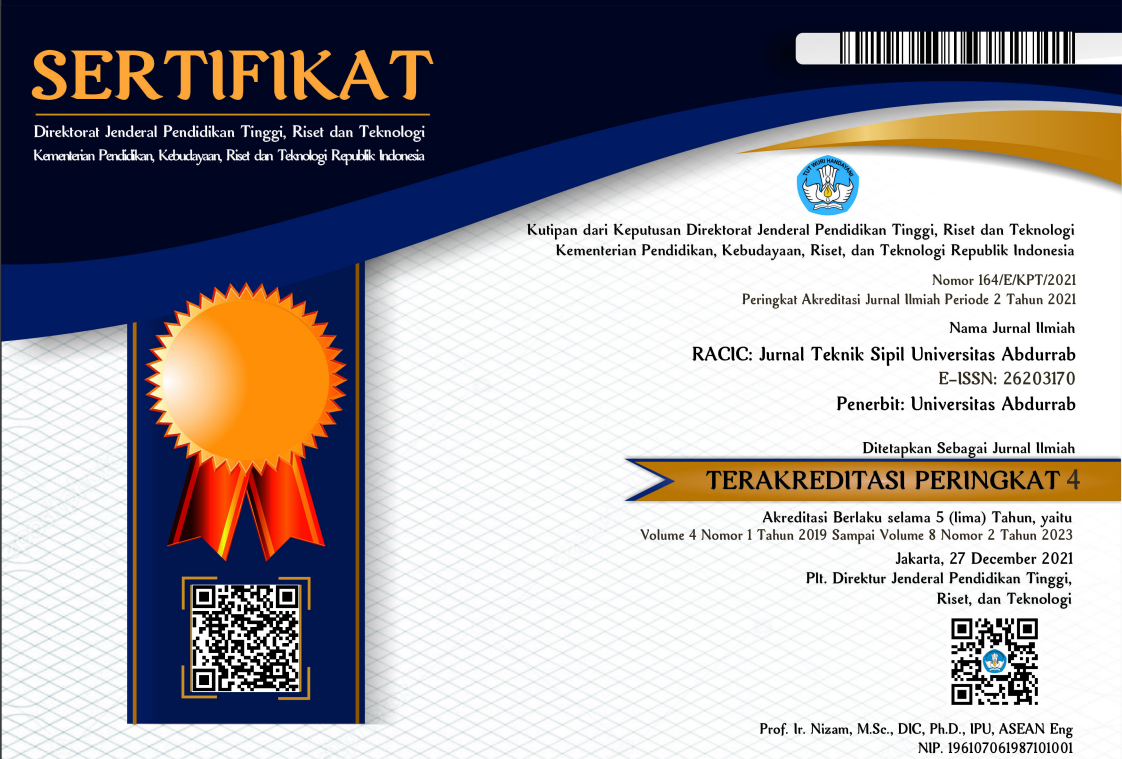PENGARUH RASIO ALKALI AKTIVATOR DALAM CAMPURAN TANAH-POFA BERDASARKAN UJI TEKAN BEBAS
DOI:
https://doi.org/10.36341/racic.v9i1.4579Keywords:
Sand; POFA; Alkali Activator: StrengthAbstract
Modern soil stabilization has included environmentally friendly materials in the mixture design. Adding an alkali activator provides an alternative to the innovation of the binder agent for soil stabilization. This study aims to know the effect of adding the alkali activator soluble for soil-POFA mixture on changes in the soil strength characteristic through an unconfined compression test (UCT). The alkali activators are sodium silica (Na2SiO3) and Sodium Hydroxide (NaOH). They prepare with a ratio Si/Al: 1.0, 1.5, 2.0, 2.5, and NaOH concentrated at 10M. Compressive strength to the soil-POFA mixture obtained slightly increased strength, and the soil is clayey sand poorly graded. However, adding the alkali activator increases the soil strength significantly. Thus, the soil-POFA with the alkali activators gained the maximum compressive strength on a ratio of 2.5, and it all has the characteristic of rapid hardening in the initial period as a binder agent.
Downloads
References
Abdullah, H. H., Shahin, M. A. and Walske, M. L. (2020) ‘Review of fly-ash-based geopolymers for soil stabilisation with special reference to clay’, Geosciences (Switzerland), 10(7), pp. 1–17. doi: 10.3390/geosciences10070249.
Firoozi, Ali Akbar et al. (2017) ‘Fundamentals of soil stabilization’, International Journal of Geo-Engineering. Springer Singapore, 8(1). doi: 10.1186/s40703-017-0064-9.
Garcia-Lodeiro, I., Palomo, A. and Fernández-Jiménez, A. (2015) An overview of the chemistry of alkali-activated cement-based binders, Handbook of Alkali-Activated Cements, Mortars and Concretes. Woodhead Publishing Limited. doi: 10.1533/9781782422884.1.19.
Ghadir, P. and Ranjbar, N. (2018) ‘Clayey soil stabilization using geopolymer and Portland cement’, Construction and Building Materials. Elsevier Ltd, 188, pp. 361–371. doi: 10.1016/j.conbuildmat.2018.07.207.
Hashim, A. N. et al. (2015) ‘Effect of Sodium Hydroxide (NaOH) Concentration on Compressive Strength of Alkali-Activated Slag (AAS) Mortars’, Applied Mechanics and Materials, 754–755, pp. 300–304. doi: 10.4028/www.scientific.net/amm.754-755.300.
Joseph Davidovits (1994) ‘Joseph Davidovits. (1994). High-Alkali Cements for 21 sf Century Concretes. ACI Special Publication, 144, 383–398.High-Alkali Cements for 21 sf Century Concretes’, ACI Special Publication, 144, pp. 383–398.
Purbasari, A., Samadhi, T. W. and Bindar, Y. (2018) ‘The effect of alkaline activator types on strength and microstructural properties of geopolymer from co-combustion residuals of bamboo and kaolin’, Indonesian Journal of Chemistry, 18(3), pp. 397–402. doi: 10.22146/ijc.26534.
Runyut, D. A. et al. (2018) ‘Microstructure and Mechanical Characterization of Alkali-Activated Palm Oil Fuel Ash’, Journal of Materials in Civil Engineering, 30(7), p. 04018119. doi: 10.1061/(asce)mt.1943-5533.0002303.
Tangchirapat, W., Jaturapitakkul, C. and Chindaprasirt, P. (2009) ‘Use of palm oil fuel ash as a supplementary cementitious material for producing high-strength concrete’, Construction and Building Materials. Elsevier, 23(7), pp. 2641–2646. doi: 10.1016/J.CONBUILDMAT.2009.01.008.
Toyeb, Muhammad, Hakam, Abdul and Andriani (2023) ‘The strength and economic benefit of soil stabilization with Palm Oil Fuel Ash (POFA) as agro-waste’, E3S Web Conf., 464, p. 11001. doi: 10.1051/e3sconf/202346411001.
Toyeb, M. et al. (2023) ‘Palm Oil Fuel Ash (POFA) as Agro-Waste to Modern Stabilization On Subgrade’, Jurnal Teknik Sipil, 12(2), pp. 165–171. doi: 10.24815/jts.v12i2.34639.
Downloads
Published
Issue
Section
License
1. Copyright of all journal manuscripts is held by the RACIC : Rab Construction Research
2. Formal legal provisions to access digital articles of electronic journal are subject to the provision of the Creative Commons Attribution-ShareAlike license (CC BY-NC-SA), which means that RACIC : Rab Construction Research is rightful to keep, transfer media/format, manage in the form of databases, maintain, and publish articles.
3. Published manuscripts both printed and electronic are open access for educational, research, and library purposes. Additionally, the editorial board is not responsible for any violations of copyright law.
licensed under a Creative Commons Attribution-ShareAlike 4.0 International License.





